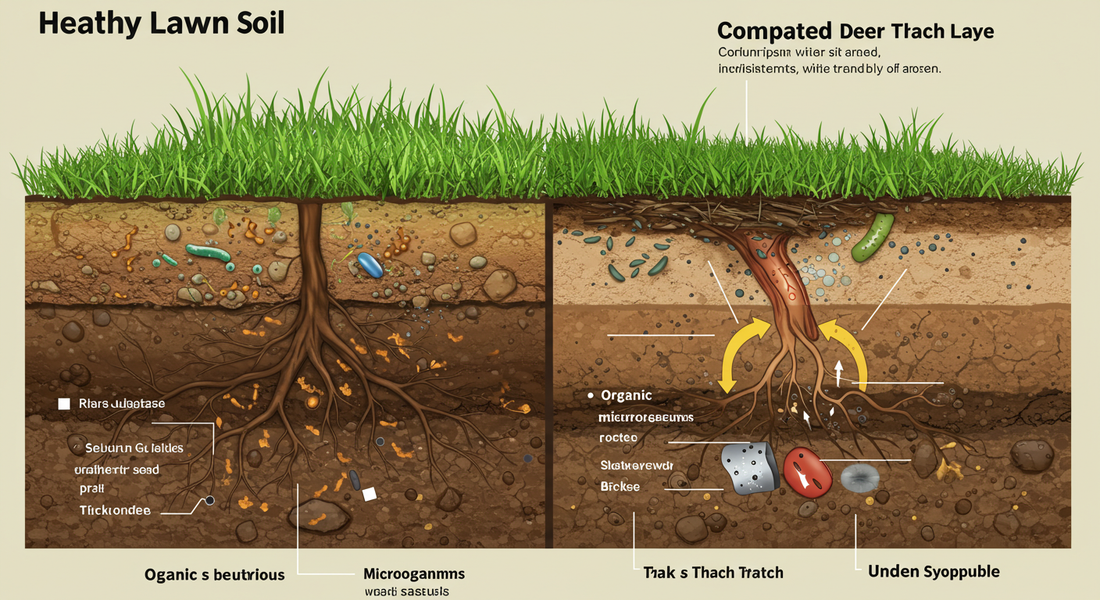
Lawn Aeration and Dethatching: The Secret to a Truly Professional-Looking Lawn
Share

You can mow perfectly, fertilize on schedule, and water diligently, but if your lawn still looks thin, patchy, or stressed, you might be missing a crucial piece of the puzzle. The secret to a truly professional-looking, carpet-thick lawn often lies in two advanced techniques: aeration and dethatching. These processes go beyond surface-level care, tackling the foundational issues of soil compaction and thatch buildup. Not sure if your lawn needs it? Try the "screwdriver test": if you can't easily push a screwdriver several inches into your moist lawn, your soil is likely too compacted. This guide will walk you through the missing links to achieving a perfect lawn.
Understanding Thatch
Before you can treat the problem, you need to understand it.
-
What is thatch and why is it a problem? Thatch is a layer of dead and living organic matter, including stems and roots, that accumulates between the green grass blades and the soil surface. A thin layer (less than half an inch) is normal and can be beneficial, but when it gets too thick, it acts like a sponge, blocking water, air, and nutrients from reaching the soil and grassroots.
-
Dethatching vs. Scalping: It's important to know how to dethatch a lawn correctly. Dethatching is the process of using a power rake or a special dethatching rake to mechanically remove this thick layer of thatch. This is different from "scalping," which simply means mowing the lawn at the lowest possible setting and can damage the grass crowns.
All About Aeration
Aeration is the process of creating small holes in the soil to allow air, water, and nutrients to penetrate.
-
Types of Aeration:
-
Core/Mechanical Aeration: This is the most effective method. A machine pulls out small plugs, or "cores," of soil from the lawn, leaving them on the surface to decompose. This physically reduces compaction.
-
Spike Aeration: This involves poking holes in the ground with solid tines. It can be useful, but it doesn't actually remove soil and can sometimes increase compaction around the holes.
-
Liquid Aeration: This involves spraying a liquid solution that helps to loosen clay and compacted soil. It's less disruptive than liquid vs mechanical aeration, but generally considered less effective for severe compaction.
-
-
The Benefits: The core aeration benefits are immense. It relieves soil compaction, allows grassroots to grow deeper and stronger, and dramatically improves the soil's ability to absorb water and fertilizer.
-
Best Time to Aerate: The best time to perform lawn aeration is during your grass type's active growing season to allow it to recover quickly. For cool-season grasses (like fescue and bluegrass), this is in the early fall. For warm-season grasses (like Bermuda and Zoysia), it's in the late spring or early summer.
Step-by-Step Guide
For the best results, dethatch your lawn before you aerate.
-
Mow and Mark: Mow your lawn slightly lower than usual and mark any sprinkler heads or invisible fence lines so you can avoid them.
-
Dethatch: Run your power rake or manual dethatching rake over the lawn. You'll pull up a surprising amount of dead material. Rake up all the debris.
-
Aerate: Run the core aerator over your lawn, making several passes in different directions to ensure good coverage. Leave the soil plugs on the lawn to break down naturally.
-
Follow Up Immediately: This is the most important step! Your lawn is now perfectly prepped for new growth. This is the absolute best time to overseed your lawn with new grass seed and apply a high-quality fertilizer. The seeds and nutrients will fall into the aeration holes, making direct contact with the soil for the best possible germination and uptake.
Conclusion: Letting Your Lawn Breathe
Aeration and dethatching are the horticultural equivalent of allowing your lawn to take a deep, refreshing breath. By removing the suffocating layer of thatch and breaking up compacted soil, you are creating the ideal environment for a dense, healthy, and resilient turf.
